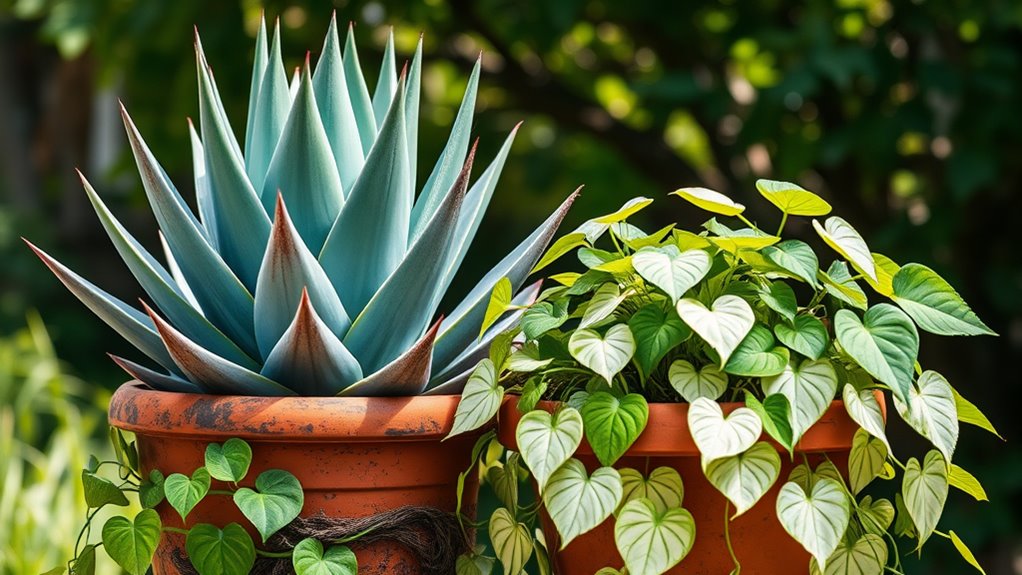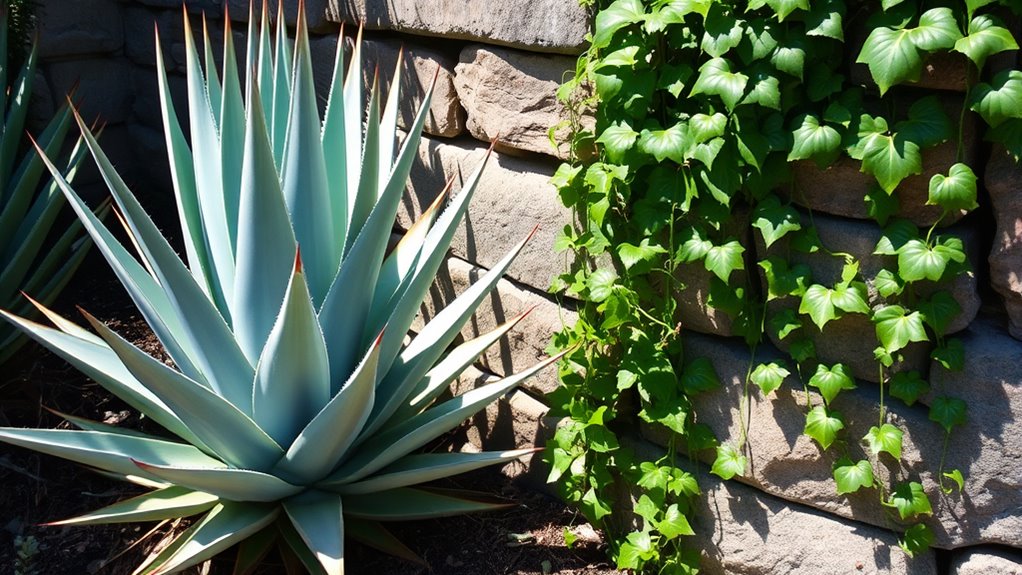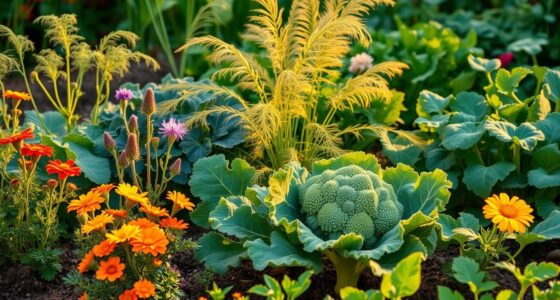Avoid planting certain crops together, as some plants can hinder each other’s growth or attract pests. For example, onions or garlic near beans release chemicals that suppress growth, while fennel can inhibit many other plants. Vegetables like cabbage and kale attract pests that could easily spread to nearby strawberries. Additionally, placing woody shrubs or trees too close can cause root competition and chemical emissions that damage your garden. Stay tuned to learn which common plant pairings to avoid for a healthier, more productive garden.
Key Takeaways
- Avoid planting onions or garlic near beans, as sulfur compounds can inhibit bean growth.
- Refrain from pairing fennel with other vegetables, since it releases chemicals that suppress nearby plants.
- Do not plant cabbage or kale close to strawberries, as they attract pests like aphids and flea beetles.
- Keep woody shrubs or trees at a distance to prevent root competition and allelopathic chemicals from hindering vegetable growth.
- Steer clear of incompatible herb and vegetable combinations, which can attract pests and cause plant stress, reducing overall garden health.

When it comes to planting a thriving garden, choosing the right neighbors is just as important as selecting the right plants. Your garden’s success depends on understanding which plants work well together and which don’t. Companion planting isn’t just about pairing aesthetically pleasing plants; it’s a strategic way to boost growth and naturally manage pests. When you plant compatible species side by side, you create an environment where beneficial insects thrive, pests are kept at bay, and plants support each other’s health. Conversely, some combinations can trigger problems, stunt growth, or attract unwanted pests, turning your garden into a battleground rather than a lush oasis.
Certain plants are notorious for being poor neighbors. For example, planting onions or garlic near beans might seem harmless, but it can inhibit bean growth because of the sulfur compounds it releases, which interfere with nutrient uptake. Similarly, planting fennel with most vegetables is a bad idea; fennel tends to release chemicals that suppress the growth of many other plants, making it a poor companion for a wide array of species. You might think pairing tomatoes with basil is a win, but not all herbs get along with all vegetables. Some plants release substances that attract pests or compete for essential nutrients. That’s why understanding these interactions is key to effective pest control; healthy, well-matched plants are less susceptible to infestations and disease.
Another common mistake is planting incompatible plants that attract different pests or diseases. For instance, planting cabbage or kale near strawberries can invite pests like aphids and flea beetles, which don’t discriminate between crops. This overlap can make pest control more difficult, forcing you to rely more heavily on pesticides or manual removal. Instead, you should aim to plant pest-repelling companions like marigolds or nasturtiums around vulnerable crops. These act as natural pest deterrents and help maintain a balanced ecosystem in your garden.
You also want to steer clear of planting woody shrubs or trees too close to garden beds. Their roots can compete aggressively for water and nutrients, stunting the growth of your vegetables. Plus, some trees release chemicals from their roots—allelopathic substances—that hinder the growth of nearby plants. These allelopathic effects can make pest control harder because stressed plants are more vulnerable to pests and disease.
Frequently Asked Questions
How Can I Identify Incompatible Plant Pairings Before Planting?
To identify incompatible plant pairings, start by researching companion planting and plant compatibility. You can check gardening guides or trusted websites to learn which plants thrive together and which don’t. Observe your garden‘s conditions, like sunlight and soil type, and consider each plant’s needs. If certain plants seem to compete for resources or attract pests, it’s best to avoid pairing them. This way, you create a healthier, more productive garden.
Do Bad Neighbor Plants Affect Overall Garden Health?
Imagine discovering that your garden’s health hinges on plant toxin interactions and root competition effects. Bad neighbor plants can indeed affect your garden’s overall health by releasing harmful substances or competing fiercely for nutrients and water. When these plants grow close, they may weaken each other, making your garden more vulnerable to pests and diseases. So, choosing compatible plants isn’t just aesthetic; it’s essential for a thriving, resilient garden.
Are There Any Natural Remedies to Mitigate Plant Conflicts?
You can use natural remedies like companion planting to reduce plant conflicts. By strategically placing pest repellent plants near problem areas, you encourage beneficial insects and deter pests, creating a healthier garden environment. Avoid planting incompatible species together, and consider using herbs like basil or marigolds, known for their pest-repelling qualities. These methods help maintain balance and prevent conflicts without chemicals, promoting a thriving, harmonious garden.
Can Bad Plant Pairings Be Corrected After Planting?
Imagine planting basil next to mint, then realizing they’re competing for root space. Yes, you can correct bad plant pairings after planting by separating roots and adjusting spacing. This helps reduce plant root competition and prevents pest attraction caused by overcrowding or poor compatibility. Regularly inspecting and pruning your plants also minimizes these issues, giving your garden a healthier, more balanced environment. Acting early is key to fixing these pairing mistakes.
Which Plants Are Most Forgiving of Poor Neighbor Choices?
When considering which plants are most forgiving of poor neighbor choices, look for those with strong resilience and adaptability. In companion planting, some plants, like marigolds or certain herbs, tolerate less compatible plantings and can even improve overall plant health. You might experiment with these because they’re more forgiving of suboptimal plant compatibility, giving you a better chance at a successful garden despite imperfect neighbor choices.
Conclusion
Think of your garden as a lively neighborhood—some plants get along like good friends, while others clash like noisy neighbors. By avoiding these bad pairings, you keep the peace and harmony alive, allowing your garden to flourish like a well-tended community. When you choose your plant neighbors wisely, your garden becomes a vibrant mosaic, each piece shining in its own perfect spot. Nurture these healthy relationships, and watch your garden thrive in beautiful, peaceful coexistence.









